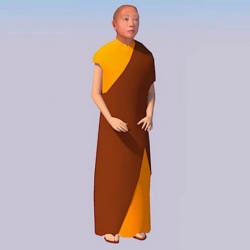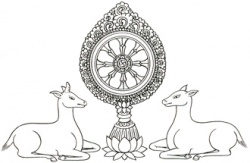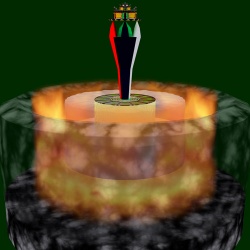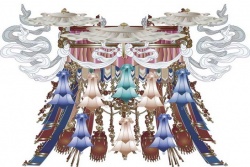Manual of Pramana - Reading Three: Quality and Characteristic
Selection from the collected topics:
Quality and Characteristic
The selection here is from the monastic textbook entitled An Explanation of the Science of Logic, included in the Advanced Path of Reasoning, a Section from the “Key to the Logic Machine,” a Presentation of the Collected Topics which Clarifies the Meaning of the Great Scriptures on Valid Perception (Tsad-ma’i gzhung-don ‘byed-pa’i bsdus-grva’i rnam-par bshad-pa rigs-lam ‘phrul gyi lde’u-mig las rigs-lam che-ba rtags-rigs kyi skor). The text was written by Purbuchok Jampa Tsultrim Gyatso (1825-1901), who in his day held the position of Tutor to the Dalai Lama.
Please note that indented statements are those made by the opponent. Responses within brackets are those that are usually left unwritten in the Tibetan text, and are understood to be there because of the context following each.
_______________
Here is the sixth section: a presentation of quality and characteristic. For this presentation we will first refute the position of our opponents, then present our own position, and then finally eliminate their rebuttal.
Suppose someone comes and makes the following claim:
Nothing which is a general category (in the sense of being a quality) can ever be a specific member of a category (in the sense of being characteristic of a quality).
Consider “working thing.”
So is it never then characteristic of a quality?
Because it is a quality.
[It doesn't necessarily follow.]
But you already agreed that it does necessarily follow.
[It's not correct to say that "working thing" is a quality.]
Consider “working thing.”
It is so a quality,
Because it has things which are characteristic of itself.
[It's not correct to say that "working thing" has things which are characteristic of itself.]
Consider “working thing.”
It does so have things which are characteristic of itself,
Because a water pitcher is one.
[It's not correct to say that a water pitcher is characteristic of "working thing."]
Suppose you say that it’s not correct [to say that a water pitcher is characteristic of "working thing"].
Consider a water pitcher.
It is so characteristic of “working thing,”
Because (1) it is a working thing; (2) it shares a relationship with “working thing” such that to be it is to automatically be a working thing; and (3) there exist multiple other objects which are both not it, but still a working thing.
[The second part of the reason you gave is not correct.]
Suppose you say that the second part of the reason we gave is not correct.
Consider a water pitcher.
It is so true, that it shares a relationship with “working thing” such that to be it is to automatically be a working thing,
Because (1) to be it is to automatically be a working thing; (2) it is something distinct from”working thing”; and (3) if there were no working things it could not never exist either.
[The first part of the last reason you gave is not correct.]
Suppose you say that the first part of the last reason we gave is not correct.
Consider a water pitcher.
It is so, that to be a water pitcher is to automatically be a working thing,
Because to be a water pitcher is by nature to be a working thing.
[The second part of the reason you gave is not correct.]
Suppose you say that the second part of the reason we gave is not correct.
Consider a water pitcher.
It is so something distinct from “working thing,”
Because it is something physical.
[The third part of the reason you gave is not correct.]
Suppose you say that the third part of the reason we gave is not correct.
Consider a water pitcher.
It is so the case, that if there were no working things it could not never exist either,
Because if there were no working things, then you could make up anything at all.
[The third part of your original reason is not correct.]
Suppose you say that the third part of our original reason is not correct.
Consider a water pitcher.
There do so exist multiple other objects which are both not it, but still a working thing,
Because a pillar of sandalwood is one, and a pillar of juniper is also one.
[Then I agree to your original statement: "working thing" is never characteristic of a quality.]
Consider “working thing.”
It is so characteristic of a quality,
Because it is characteristic of “knowable things.”
[Your reason is not correct.]
Suppose you say that it is not correct [to say that "working thing" is characteristic of "knowable things"].
Consider “working thing.”
It is so characteristic of “knowable things,”
Because (1) a working thing is a knowable thing; (2) it shares a relationship with “knowable things” such that to be it is to automatically be a knowable thing; and (3) there exist multiple objects which are both not a working thing, but still knowable thing.
_______________
Suppose someone comes and makes the following claim:
If something is a quality of which “working thing” is characteristic, then it is always a quality of which “able to performa function” is characteristic.
Consider “thing to be defined.”
So is it then a quality of which “able to performa function” is characteristic?
Because it is a quality of which “working thing” is characteristic.
[It doesn't necessarily follow.]
But you already agreed that it does necessarily follow.
[It's not correct to say that "thing to be defined" is a quality of which "working thing" is characteristic.]
Consider “thing to be defined.”
It is so a quality of which “working thing” is characteristic,
Because “working thing” is characteristic of it.
[It's not correct to say that "working thing" is characteristic of "thing to be defined."]
Suppose you say that it’s not correct [to say that "working thing" is characteristic of "thing to be defined"].
Consider “working thing.”
It is so characteristic of “thing to be defined,”
Because (1) it is a thing to be defined; (2) it shares a relationship with “thing to be defined” such that to be it is to automatically be a thing to be defined; and (3) there do exist multiple other objects which are both not it and yet are still things to be defined.
[Then I agree with your original statement: "thing to be defined" is a quality of which "able to performa function" is characteristic.]
Suppose you agree with our original statement, [saying that "thing to be defined" is a quality of which "able to performa function" is characteristic).
It is not so, that “thing to be defined” is a quality of which “able to performa function” is characteristic,
Because it ["able to performa function'] is the definition of a working thing.
_______________
Suppose someone comes and makes the following claim:
Anything which is a quality of which “working thing” is characteristic must also be a quality of which “changing thing” is characteristic.
Consider “distinct from’changing thing’.”
So is it then a quality of which “changing thing” is characteristic?
Because it is a quality of which “working thing” is characteristic.
[It doesn't necessarily follow.]
But you already agreed that it does necessarily follow.
Suppose you say that it’s incorrect to say [that "distinct from'changing thing'" is a quality of which "working thing" is characteristic).
Consider “distinct from’changing thing’.”
It is so a quality of which “working thing” is characteristic,
Because “working thing” is characteristic of it.
[Then I agree with your original statement: "distinct from 'changing thing' " is a quality of which "changing thing" is characteristic.]
Suppose you agree to our original statement, [saying that "distinct from 'changing thing'" is a quality of which "changing thing" is characteristic).
It’s not so, that “distinct from’changing thing’ ” is a quality of which “changing thing” is characteristic,
Because “changing thing” is not characteristic of it.
[It's not correct to say that "changing thing" is not characteristic of "distinct from'changing thing'."]
Suppose you say that it’s not correct [to say that "changing thing" is not characteristic of "distinct from'changing thing' "].
Consider “changing thing.”
It is so [not correct to say that it is characteristic of the quality of "distinct from 'changing thing',"]
Because it is not distinct from”changing thing.”
[It's not correct to say that "changing thing" is not distinct from "changing thing."]
Suppose you say it’s not correct [to say that "changing thing" is not distinct from"changing thing"].
It is so true, that it is not distinct fromitself,
Because it is an example of something where the person has no nature of its own.
_______________
Suppose someone comes and makes the following claim:
There exists no one thing which is both (1) a quality of a quality of which something is characteristic, and also (2) characteristic of something which is characteristic of a certain quality.
Isn’t it though so, that there is such a thing?
Because “unchanging thing” is just such a thing.
[It's not correct to say that "unchanging thing" is one thing which is both (1) a quality of a quality of which something is characteristic, and also (2) characteristic of something which is characteristic of a certain quality.]
Consider “unchanging thing.”
It is so one thing which is both (1) a quality of a quality of which something is characteristic, and also (2) characteristic of something which is characteristic of a certain quality,
Because it is a quality of which “quality” is characteristic, and it is characteristic of the quality of “characteristic.”
[The first part of your reason is not correct: it's not correct to say that "unchanging thing" is a quality of which "quality" is characteristic.]
Consider “unchanging thing.”
It is so a quality of which “quality” is characteristic,
Because “quality” is something which is characteristic of it.
[The second part of your reason is not correct: it's not correct to say that "unchanging thing" is characteristic of the quality of "characteristic."]
Suppose you disagree to the second part of our reason, [saying that it's not correct to say that "unchanging thing" is characteristic of the quality of "characteristic"].
Consider “unchanging thing.”
It is so characteristic of the quality of “characteristic,”
Because (1) it is characteristic of a quality; (2) it has a relationship with “characteristic” such that to be it is to automatically be characteristic of a quality; and (3) there exist multiple things which are both not it, but still characteristic of a quality.
_______________
Someone may come and make the following claim:
Nothing which is a quality of which “unchanging thing” is characteristic can ever be characteristic of the quality “unchanging thing.”
Consider “quality.”
So is it then never characteristic of the quality “unchanging thing”?
Because it is a quality of which “unchanging thing” is characteristic.
[It's incorrect to say that "quality" is a quality of which "unchanging thing" is characteristic.]
It is so a quality of which “unchanging thing” is characteristic,
Because “unchanging thing” is characteristic of the quality “quality.”
[It's incorrect to say that "unchanging thing" is characteristic of the quality "quality."]
It is so characteristic of the quality “quality,”
Because (1) “unchanging thing” is a quality; (2) “unchanging thing” has a relationship with “quality” such that to be “unchanging thing” is to automatically be a quality; and (3) there exist multiple things which are both not an unchanging thing, but still a quality.
[Then I agree with your original statement: "quality" is never characteristic of the quality "unchanging thing."]
Suppose you agree with our original statement, [saying that "quality" is never characteristic of the quality "unchanging thing"].
Consider “quality.”
It is so characteristic of the quality “unchanging thing,”
Because (1) it is an unchanging thing; (2) it has a relationship with “unchanging thing” such that to be “quality” is to automatically be an unchanging thing; and (3) there exist multiple things which are both not “quality,” but still an unchanging thing.
_______________
Suppose someone comes and makes the following claim:
It’s not necessarily the case that anything which is a quality of which “changing thing” is characteristic can never be characteristic of the quality “changing thing.”
But this is incorrect,
Because there exists nothing which is both a quality of which “changing thing” is characteristic and which is also characteristic of the quality “changing thing.”
[It's not correct to say that there exists nothing which is both a quality of which "changing thing" is characteristic and also characteristic of the quality "changing thing."]
It is so [correct to say that there exists nothing which is both a quality of which "changing thing" is characteristic and which is also characteristic of the quality "changing thing"],
Because there exists neither an unchanging version nor a changing version [of something which is both a quality of which "changing thing" is characteristic and which is also characteristic of the quality "changing thing"].
[It's not correct to say that there exists no unchanging version.]
The first point in the reason is so [that is, it is correct to say that there exists no unchanging version of something which both a quality of which "changing thing" is characteristic and which is also characteristic of the quality "changing thing"],
Because something which is an unchanging thing can never be characteristic of the quality “working thing”;
Which is to say, if something is unchanging, it can never be a working thing.
[It's not correct to say there exists no changing version.]
The second point in our reason is so [—that is, it is correct to say that there exists no changing version of something which both a quality of which "changing thing" is characteristic and which is also characteristic of the quality "changing thing"],
Because if there existed a changing thing that could be a quality of which “changing thing” is characteristic, then you could make up anything at all.
_______________
Suppose someone comes and makes the following claim regarding our statement that, if something is a working thing, it can never be a quality of which “working thing” is characteristic:
Consider the fact that sound is a changing thing.
Is it then [not a quality of which "working thing" is characteristic)?
Because it is a working thing.
Our definitive answer would be to say, “It’s not correct [to say that this fact is a working thing"].
[Then I agree with the original statement: the fact that sound is a changing thing is not a quality of which "working thing" is characteristic.]
But you cannot agree to the original statement,
Because the fact that sound is a changing thing is a quality of which “working things” is characteristic,
Because working things are characteristic of the fact that sound is a changing thing.
[It's not correct to say that working things are characteristic of the fact that sound is a changing thing.]
It is so [correct to say that working things are characteristic of the fact that sound is a changing thing],
Because (1) working things are “sound is a changing thing”; (2) working things are related to “sound is a changing thing” in such a way that to be a working thing is to automatically be “sound is a changing thing”; and (3) there exist multiple other things which are both not a working thing and yet still “sound is a changing thing.”
[The final part of your reason is not correct; that is, it is not correct to say that there exist multiple other things which are both not a working thing and yet still "sound is a changing thing."]
The final part of our reason is so true; [that is, it is correct to say that there exist multiple other things which are both not a working thing and yet are still "sound is a changing thing"],
Because “existing things” are one, and “unchanging things” are one as well.
[It's wrong to say that "existing things" and "unchanging things" are things which are both not a working thing and yet are still "sound is a changing thing."]
It is so [correct, to say that "existing things" and "unchanging things" are things which are both not a working thing and yet are still "sound is a changing thing"],
Because anything which has no self-nature is always “sound is a changing thing.”
_______________
Suppose someone comes and makes the following claim:
Anything which is characteristic of the quality “mental object” is also always characteristic of the quality “working thing.”
Consider the two of valid perception and reflection that act as a cause for a working thing.
So are they then (characteristic of the quality "working thing"]?
Because they are (characteristic of the quality "mental object"].
[It doesn't necessarily follow.]
But you already agreed that it does necessarily follow.
[It's incorrect to say that the two of valid perception and reflection that act as a cause for a working thing are characteristic of the quality "mental object."]
Suppose you say that it’s incorrect [to say that the two of valid perception and reflection that act as a cause for a working thing are characteristic of the quality "mental object"].
They are so (characteristic of the quality "mental object"],
Because (1) the two of themare mental objects; (2) they share a relationship with “mental object” such that to be the two of them is to automatically be the mental object; and (3) there exist multiple things which are not the two of thembut are still mental objects.
The first and second parts of our reason are easy to accept; suppose you say that the third is not correct; [which is to say, there do not exist multiple things which are both not the two of valid perception and reflection, but which are still mental objects].
It is so true, that there exist multiple things which are both [not the two of valid perception and reflection, but which are still mental objects],
Because omniscience is just such a thing, and valid perception is just such a thing—the two do exist as separate things.
[Then I agree with your original statement: the two are characteristic of the quality "working thing."]
Suppose you agree with our original statement.
Consider these same two.
They are not so—they are not characteristic of the quality “working thing,”
Because they cannot share a relationship with “working thing” such that to be themis to automatically be the working thing.
[It's not correct to say that they cannot share a relationship with "working thing" such that to be themis to automatically be the working thing.]
Suppose you say that it’s not correct [to say that they cannot share a relationship with "working thing" such that to be themis to automatically be the working thing].
Consider these same two.
It is so correct [to say that they cannot share a relationship with "working thing" such that to be themis to automatically be the working thing],
Because they are the cause of the working thing.
Our reason is easy to accept.
_______________
Here secondly is the part where we present our own position. There does exist a definition of “something general,” because “any existing thing which subsumes its members” is the definition.
Nominally speaking, things that are “general” may be divided into three different types: general things as far as types, general things as far as objects, and general things as far as collections of parts.
There does exist a definition of a “general thing as far as types” (or “quality”), because “that existing thing which subsumes the multiple things which are of its type” is the definition.
A classical example of a “general thing as far as types” (or “quality”) does exist, because “knowable things” is one.
There does exist a definition of a “general thing as far as objects” (or “actual mental image”) relating to a water pitcher, because it is the following: “That element which is imputed to be the water pitcher, but which is not: that thing which appears to be the water pitcher to the conceptual state of mind which is perceiving a water pitcher, but which is however not the water pitcher.”
A classical example of a “general thing as far as objects” (or “actual mental image”) does exist, because “the appearance, to the second instant of a conceptual state of mind which is perceiving a water pitcher, of the opposite of all that is not the water pitcher of the second instant” is just this kind of example.
There does exist a definition of a “general thing as far as a collection of parts,” because it is the following: “A gross physical object which is composed of its multiple parts.”
Classical examples of a “general thing as far as a collection of parts” do exist, because a water pitcher or a pillar would each be one.
There does exist one thing which is both a “general as far as a collection of parts” and a “general as far as types” (or “quality), because the water pitcher would be one.
There does exist one thing which is both not a “general as far as a collection of parts” and yet still a “general as far as types” (or “quality”), because “knowable things” would be one.
There does exist one thing which is both not a “general as far as types” (or “quality”) and yet still a “general as far as a collection of parts,” because the two of a pillar and a pitcher would be one.
There does exist one thing which is neither a “general as far as types” (“quality”) nor a “general as far as a collection of parts,” because the two of “changing things” and “unchanging things” would be one.
There does exist a definition of a “member” (or “something characteristic of a particular quality”), because “an existing object which is an example of a particular type which subsumes it” is this very definition.
_______________
Here finally is the third part, eliminating any rebuttal concerning our position.
Suppose someone comes and makes the following claim:
Consider the two of a pillar and a water pitcher.
They are so something general,
Because they are generals in the sense of a collection of parts.
To this we answer, “It is not necessarily the case.”
The reason though is correct, because they are units composed of molecules containing the eight substances, [which are: the four elements of earth, water, fire, and wind; and the four objects of visual form, smells, tastes, and touches].
[Then I agree to your statement: I agree that the two of a pillar and a water pitcher are something general.]
Suppose you agree to our statement, [and agree that the two of a pillar and a water pitcher are something general].
It is not so, that they are something general, a general quality,
Because there is nothing which is characteristic of them.
[It's not correct to say that there is nothing which is characteristic of a pillar and a water pitcher.]
Suppose you say that it’s not correct [to say that there is nothing which is characteristic of a pillar and a water pitcher].
Consider these same things.
It is so true, [that there is nothing which is characteristic of a pillar and a water pitcher],
Because they are a knowable object which is not.
______________
Suppose someone comes and makes the following claim:
Isn’t it so, that “knowable objects” itself is not a quality?
Because isn’t it not a quality of which that thing which is “knowable objects” is characteristic?
Our answer is: “It doesn’t necessarily follow.”
[It's not correct to say that "knowable objects" is not a quality of which that thing which is "knowable objects" is characteristic.]
Suppose you say that it’s not correct [to say that "knowable objects" is not a quality of which that thing which is "knowable objects" is characteristic).
It is so true, that it is not a quality of which that thing which is “knowable objects” is characteristic,
Because there exists no quality of which that thing which is “knowable objects” is characteristic.
[It's not correct to say that there is no quality of which that thing which is "knowable objects" is characteristic.]
Suppose you say that it’s not correct [to say that there is no quality of which that thing which is "knowable objects" is characteristic).
It is so [correct to say that there is no quality of which that thing which is "knowable objects" is characteristic),
Because (1) there exists no quality of which “knowable objects” is characteristic, and (2) “knowable objects” and “that thing which is knowable objects” are synonyms.
[Then I agree to the statement above: "knowable objects" itself is not a quality.]
Suppose you agree to the statement above, [and say that "knowable objects" itself is not a quality].
Consider “knowable objects.”
It is so a quality,
Because it is an existing thing which subsumes its members.
[It's not correct to say that "knowable objects" is an existing thing which subsumes its members.]
Suppose you say that it’s not correct [to say that "knowable objects" is an existing thing which subsumes its members.]
Consider this same thing.
It is so [an existing thing which subsumes its members],
Because it is an existing thing which subsumes the multiple members which are of its type.
[It's not correct to say that "knowable objects" is an existing thing which subsumes the multiple members which are of its type.] Suppose you say that it’s not correct [to say that "knowable objects" is an existing thing which subsumes the multiple members which are of its type.]
Consider this same thing.
It is so [an existing thing which subsumes the multiple members which are of its type],
Because it subsumes the multiple members which are of its type.
[It's not correct to say that "knowable objects" subsumes the multiple members which are of its type.]
Consider this same thing.
It is so true, [that it subsumes the multiple members which are of its type],
Because all objects, whether they are unchanging things or working things, are of its type.
_______________
Suppose someone returns and makes the following claim:
Is it then so, that “knowable things” is a quality of which “not being” is characteristic?
Because “not being” is characteristic of the quality “knowable things.”
Our answer is: “It’s not necessarily the case.”
[Then I agree to the statement: It is so, that "knowable things" is a quality of which "not being" is characteristic.]
Suppose you agree to the statement, [and say that "knowable things" is a quality of which "not being" is characteristic).
It is not so, that “knowable things” is a quality of which “not being” is characteristic,
Because if something were a quality of which something that was not a knowable thing were characteristic, then you could always make up anything at all.
_______________
Suppose again that someone makes the following claim:
It is so that there exists something which is characteristic of something which is not characteristic of something,
Because it is true that there exists something which is a quality of something which is not a quality.
Our answer is, “It doesn’t necessarily follow.”
It is correct by the way to say that there does exist something which is a quality of something which is not a quality,
Because “knowable things” is something which is a quality of something which is not a quality.
[It's not correct to say that "knowable things" is something which is a quality of something which is not a quality.]
Suppose you say that it’s not correct [to say that "knowable things" is something which is a quality of something which is not a quality].
Consider “knowable things.”
It is so a quality of something which is not a quality,
Because “something which is not a quality” is characteristic of it.
_______________
Suppose again that someone comes and makes the following claim:
Consider “knowable things.”
It isn’t so, that it is a quality of that which is not a quality,
Because it is a quality of that which is “quality.”
Our answer is, “It doesn’t necessarily follow.”
It is true though to say that “knowable things” is a quality of that which is “quality,” because “quality” is characteristic of it.
_______________
Suppose someone comes again and makes the following claim:
Isn’t it so, that “unchanging things” is not characteristic of “sound is a changing thing”?
Because isn’t it true, that “working things” is characteristic of “sound is a changing thing”?
Our answer is, “It doesn’t necessarily follow.”
It is so true, that “unchanging things” is characteristic of “sound is a changing thing,”
Because “sound is a changing thing” is an existing thing which subsumes its member “unchanging things.”
[It's incorrect to say that "sound is a changing thing" is an existing thing which subsumes its member "unchanging things."]
It is so true [that "sound is a changing thing" is an existing thing which subsumes its member "unchanging things"],
Because it does have a member called “unchanging things.”
And this is true because both “unchanging things” and “working things” are members that it has.
______________
Suppose someone comes and makes the following claim:
Consider “existing things.”
So it must then be characteristic of something,
Because it is an existing object which is an example of a particular type which subsumes it.
[It's incorrect to say that it is an existing object which is an example of a particular type which subsumes it.]
It is so an existing object which is an example of a particular type which subsumes it,
Because there does exist an existence which subsumes it.
Our answer is, “It doesn’t necessary follow.” And this is because there is a very important point served by saying the words “an example” in the definition of being characteristic of something.
Similar cases, dissimilar cases, and “similar examples” in a logical statement
This brings us to the second section of our explanation of the pivotal objects: an explanation of the pivotal object in the necessary relationships between the quality to be proven and the reason—that is, the groups of similar cases and dissimilar cases. We will proceed in two steps: the actual explanation, and an incidental treatment of the similar example and the dissimilar example. The first of these comes in four parts of its own:
1) definitions;
2) divisions;
3) a calculation of the permutations based on whether the cases actually fit their name; and
4) an analysis of whether the groups of similar cases and dissimilar cases are directly contradictory or not.
Here is the first. The following is the definition of the group of similar cases in a proof that sounds are changing things:
All those things which are not void of the quality of being changing things, in keeping with the way in which sounds are proven to be changing things in any particular logical statement.
“Changing things” and the group of similar cases in just such a proof are such that to be one is always to automatically be the other.
The following is the definition of the group of dissimilar cases:
All those things which are void of the quality of being changing things, in keeping with the way in which this proof is made in the particular logical statement.
“All that is not a changing thing” and this same group are such that to be one is always to be the other.
Here secondly are the divisions. The group of dissimilar cases can come in three different types:
1) The group of dissimilar cases that are not existing things;
2) The group of dissimilar cases that are something else; and
3) The group of dissimilar cases that are directly contradictory.
An example of the first would be the horns on a rabbit’s head. An example of the second would be “knowable things.” An example of the third would be “unchanging things.”
Here is the third part. One may ask the following:
If something is part of a group of similar cases in any particular proof, is it then necessarily part of such a group in such a way that it fits the name of the group?
Three of the permutations here hold. There do exist the following:
1) Something which is part of a group of similar cases in a particular proof, but which is not part of this group in such a way that it fits the name of the group;
2) Something which is both [part of a group of similar cases in a particular proof and which is also part of this group in such a way that it fits the name of the group]; and
3) Something which is neither [part of a group of similar cases nor part of this group in such a way that it fits the name of the group].
“That unproduced thing which is empty space” is an example of the first permutation: it is something which is part of a group of similar cases in a proof that sounds are unchanging things, but it is not part of this group in such a way that it fits the name of the group.
Here is a proof that this is true:
Consider this same thing [unproduced, empty space).
It is a part of the group of similar cases in the proof mentioned,
Because it is an unchanging thing.
It is not part of this group in such a way that it fits the name of the group,
Because it is not a thing which is similar to sounds in the sense that they are both unchanging things.
Now for the second permutation: something which is both. A water pitcher is both something which is part of the group of similar cases in a proof that sound is changing, and also something which is part of this group in such a way that it fits the name of the group.
Here is a proof that this is true:
Consider a water pitcher.
It is so something which is part of the group of similar cases of this same proof,
Because it is a changing thing.
Consider this same thing.
It is a part of this group in such a way that it fits the name of the group,
Because it is a thing which is similar to sounds in the sense that they are both changing things: a water pitcher is a changing thing, and a sound is also a changing thing.
Next is the permutation where something is neither. “The unproduced thing called ‘empty space’” is something which is neither part of the group of similar cases in a proof that sound is a changing thing, nor a part of this group in such a way that it fits the name of the group.
Here is a proof that this is true:
Consider this same thing.
It is so true, that it is not a part of the group of similar cases in this same proof,
Because it is not a changing thing.
Consider this same thing.
It is so true, that it is not a part of this same group in such a way that it fits the name of the group,
Because it is not a thing which is similar to sounds in the sense that they are both changing things: it is an unchanging thing, and sound is a changing thing.
There does not exist anything which would qualify as the final permutation; that is, something which was a part of the group of similar cases in such a way that it fit the name of the group, but which was not a part of the group of similar cases. This is because anything which is part of the group of similar cases in such a way that it fits the name of the group must also be part of the group of similar cases.
When we speak of the “group” (chok) in the “group of similar cases” (tunchok) we are not necessarily speaking only of the quality to be proven in the particular proof. This is because we have to draw a distinction between the “group” in the “group of similar cases in a proof that sounds are changing things” and being part of the group of similar cases in the same proof. [This distinction has already been drawn for the reader in the translation above.]
It’s easy to see how you would prove someone wrong if they replied, “It doesn’t necessarily follow.”
Suppose though you say,
It’s not correct [to say that we have to draw a distinction between the "group" in the "group of similar cases in a proof that sounds are changing things" and being part of the group of similar cases in the same proof).
It is so correct to say this, because there are three different things that the word chok can make you think of—there are three different things that the word chok can refer to—when we speak of the “chok” in a proof that sounds are changing things. The chok in the word chokchu (“relationship between the subject and the reason”) refers to the subject in the particular logical statement: the thing which the opponent doubts possesses the quality to be proven.
Then there are pair of further uses of this word: the chok we use when we are discussing whether or not something is part of the group of similar cases (tunchok), and the chok we use when we are discussing the object related to, within the necessary relationships in a logical statement (kyappay drelyul gyi chok). Both of these refer to the general type represented by the quality to be proven, or—in this case—the general type represented by “changing thing.” Finally there is the word chok as we use it in the expression “group of similar cases” (tunchok) itself. Here the word must be understood as referring to everything: to both the general type and the specific instance represented by “changing thing.”
One may ask the following question:
If something is part of the group of dissimilar cases for a particular proof in such a way that it fits the name of the group, is it then always something which is part of the group of dissimilar cases for the particular proof?
Three permutations hold here. The unproduced thing which is empty space is an example of the permutation where something is part of the group of dissimilar cases in the proof that sounds are unchanging things in such a way that it fits the name of the group, but is not part of the group of dissimilar cases.
A water pitcher would be an example of the permutation where something is neither, in a proof that sound is a changing thing.
The unproduced thing which is empty space would be an example of the permutation where something is both part of the group of dissimilar cases in the proof that sounds are changing things in such a way that it fits the name of the group; and is also part of the group of dissimilar cases.
One permutation here does not hold: where something is part of the group of dissimilar cases in the particular proof, but not part of the group of dissimilar cases for the particular proof in such a way that it fits the name of the group.
This is because anything that is part of the group of dissimilar cases in a particular proof is always part of the group of dissimilar cases in the particular proof in such a way that it fits the name of the group.
Here lastly is the fourth point: an analysis of whether the groups of similar cases and dissimilar cases are directly contradictory or not. The group of similar cases stands in direct contradiction to the group of dissimilar cases, but the group of dissimilar cases does not stand in direct contradiction to the group of similar cases. This is because the group of dissimilar cases does not exist.
And this is true because any object which can be established as existing is always part of a group of similar cases. And this is because any object which can be established as existing is always a part of a group of similar cases for some correct reason. And this is because any object which can be established as existing is always a part of the group of similar cases for a correct reason in the proof that sound in a knowable thing.
On this point, someone might come and make the following claim:
It is so true, that the group of dissimilar cases exists,
Because there does exist a group of dissimilar cases for the proof that sounds are changing things; and also because there does exist a “correct statement of proof that relates to what is dissimilar.”
Our answer would be: it doesn’t necessary follow.
[An actual example of a "correct statement of proof that relates to what is dissimilar" would be the following:
Things that are unchanging are always things that are not made—
It's like the example of empty space, an unproduced thing;
And so, sounds are things that are made.]
Here is the second major topic—an incidental treatment of the similar example and the dissimilar example.
The definition of a similar example is: “Anything considered a similar example.” Anything that lacks a self-nature is always a similar example, because anything which can be established as existing [that is, which does exist,] is always a similar example, and anything which cannot be established as existing [that is, which doesn't exist,] is also always a similar example.
[The first part of your statement is not correct.] It is so true, that the first part of our statement is correct,
Because “water pitcher” is one [similar example], and it is equivalent [to the case in question].
[The second part of your statement is not correct.]
It is so true, that the second part of our statement is correct,
Because “the horns on the head of a rabbit” is one [similar example], and it is equivalent [to the case in question].
[The first part of your latest statement is not correct.]
Suppose you say that the first part of our last statement is not correct.
Consider the horns on the head of a rabbit.
They are too [a similar example],
Because they can be considered a similar example in a proof that sounds are changing things.
And this is true because there could exist a logical statement where someone said:
Consider sounds.
They are changing things,
Because they are things that are made;
It’s just like the example of those [horns on a rabbit's head].
It is also true because there could exist a statement of proof where someone said:
Anything that is made
Is always something that is changing;
It’s just like the example of those [horns on a rabbit's head].
Here is the definition of a similar example in a proof that sounds are changing things:
Anything that can be considered a similar example in a proof that sounds are changing things.
Anything that lacks a nature of its own is always just such an example,
Because anything that can be established as existing…(and then you can just follow the same pattern as above). You can apply all this as well to a proof where “because it is something made” is used as the reason for the same assertion.
“Anything which is considered a dissimilar example” is not, however, the definition of a dissimilar example. This is because no dissimilar example exists: anything that can be established as existing is always a correct similar example.
There does however exist a correct dissimilar example for the proof that sounds are changing things; we’ve established all this already, earlier on.
The Two Responses to a Statement of a Reason
The great beauty of debate is that, assuming both parties stick to the rules of logic, we must arrive at truth. If the attacker in any particular exchange poses a series of questions in a correct, logical order, all the defender must do is give very simple answers reflecting his own beliefs—answers like “yes,” or “no”—and sooner or later the truth will out. This is much like the way in which a computer program works, with switches at each logical decision point, turned “on” or “off” to indicate “yes” or “no”—and then continue on to this branch, and answer “yes” or “no,” until the flowchart takes you where you must eventually go.
In an actual debate, the attacker will give his assertion in three parts: the statement of the subject, the quality to be proven about the subject, and the reason why this quality must be one that the subject possesses. He or she might say, for example,
Consider sounds.
They are changing things,
Because they are something hot to touch.
Here “sounds” are the subject, “being a changing thing” is the quality we are trying to prove about them, and “because they are things that are something hot to touch” is the full statement of the reason we give to prove that this quality does apply to the subject in question.
This is the most common form of logical statement in a Buddhist debate, and in Tibetan ends with the word chir, which is the word for “because.” (In Tibetan sentence order, the “because” comes at the end.) A defender who hears a statement ending in chir immediately begins to think of two possible answers. The first answer is tak ma drup (rtags ma grub), which basically means, “the reason you gave doesn’t apply to the subject.” In our case above this is to say, “It’s incorrect to say that sounds are something hot to touch.”
Suppose that the attacker had instead made the following statement:
Consider sounds.
They are changing things,
Because they exist.
Here it would be incorrect to answer tak ma drup, or “the reason you gave doesn’t apply to the subject,” because it is true that “existing” applies to “sounds”—that is, sounds do exist. Instead, the defender would answer kyappa ma jung (khyab pa ma byung), or “it doesn’t necessarily follow.” This is the same as saying, “I admit it’s true that sounds exist, but it doesn’t necessarily follow then that they have to be changing things.” After all, there are things—like emptiness or empty space—which exist but are not changing things.
Both of these answers are equivalent to saying “no,” but for different reasons. They are the two classic answers because, if we assume a debate is about to take place, the attacker should begin with something to argue about—something the defender does not accept.
There are times in a debate though where an attacker is attempting to establish a certain context—trying to get the defender to accept one thing in order to go on to something else that he or she does not accept. An example would be the following:
Consider sounds.
They are changing things,
Because they are things that are made.
This is a correct statement, and so the defender answers “yes” or “right.” The way to give such an answer in the Tibetan language is to simply repeat the verb that the opponent has used in his or her statement. With this last statement, for example, the defender would simply say, Yin!—or “They are!” meaning, “Yes! They are things that are made!”
The last thing to know about these answers is: Think carefully before you choose which one to say! It’s quite acceptable in a debate to mull over your opening response carefully, since this already decides which side of the truth you will end up at, when both you and your opponent reach the inevitable conclusion of the flowchart.
See also
- Manual of Pramana - Reading One: Why Study the Art of Reasoning?
- Manual of Pramana - Reading Two: An Outline of All Existing Things
- Manual of Pramana - Reading Three: Quality and Characteristic
- Manual of Pramana - Reading Four: Causes and Results
- Manual of Pramana - Reading Six: Negative and Positive
- Manual of Pramana - Reading Seven: Contradiction and Relationship
- Manual of Pramana - Reading Eight: Definitions and the Things They Define
- Manual of Pramana - Reading Nine: The Concept of Exclusion in Perception
- Manual of Pramana - Reading Ten: The Concept of Time
- Manual of Pramana - CLASS NOTES part 1
- Manual of Pramana - CLASS NOTES part 2














































